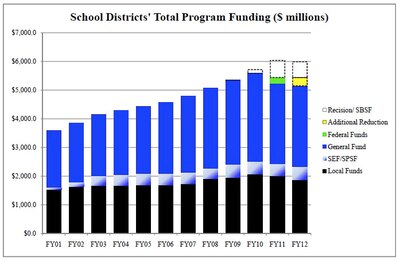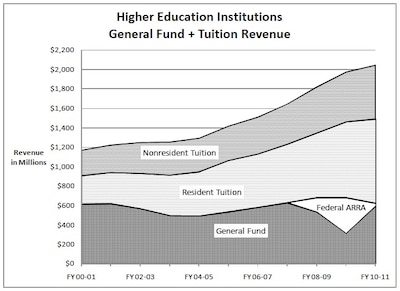There were faint glimmers of budgetary hope during a key Joint Budget Committee hearing Thursday, but they only involved variation in the possible size of cuts.

“There will be cuts to K-12. The question is how big,” said Rep. Mark Ferrandino, D-Denver, during the afternoon figure-setting session for the Department of Education.
The analysis presented to the committee by staff member Carolyn Kampman suggested that K-12 cuts next year could be as low as $290 million for 2011-12, instead of the $332 million proposed by the Hickenlooper administration. But a lot of financial pieces would have to fall into place for that to happen, including taking money from other education programs and from state school lands revenues.
Cuts also are unavoidable for the state colleges and universities, the subject of a morning figure-setting session. The good news there, from a college president’s point of view, was that the committee decided not to go with the deeper cuts proposed by staff analyst Eric Kurtz, instead opting for the smaller bite proposed by the Hickenlooper administration.
The JBC hearings Thursday kicked off what will be a crucial two weeks in legislative deliberations on the 2011-12 budget. The committee is expected to finish figure setting for all departments by the middle of next week, after which the staff will tote things up to see if the proposed budget is balanced. If the committee will need to trim some more.
Next Friday, March 18, fresh state revenue estimates will be given to the JBC by legislative and executive branch economists. If those estimates are rosier than the ones made in December, budget cuts won’t need to be as large as proposed. If state revenues have weakened, it’ll be time to cut deeper.
JBC staff director John Ziegler told committee members they’ll need to decide no later than March 22 how much of a K-12 cut to propose in order to have a balanced budget.

The committee deferred that decision Thursday, with Ferrandino saying, “I’d rather do that target after the revenue forecast.” (School finance is controlled by two different bills – the main state budget, called the “long bill,” and the annual school finance act. The target Ferrandino referred to is the amount of the cut that will be dictated by the school finance act.)
To complicate things further, legislative Democrats, particularly in the Senate, are scrambling to find additional revenues and cuts to other programs that can be applied to K-12 spending.
One such proposal, Senate Bill 11-184, was passed by the Senate Finance Committee Thursday. It would establish a tax amnesty program next summer, with the extra revenue collected going to education. Some estimates put that at up to $15 million. Whether that plan and any others the Democrats come up with will succeed in the Republican-controlled House is iffy.
While the committee put off the big K-12 decision, it did approve several other Kampman recommendations that cut specialized education programs.
Those included cutting the Colorado Counselor Corps from $5 million to $2.5 million (Kampman recommended zero), elimination of funding for the Closing the Achievement Gap program and shutting down the School Leadership Academy.
Many such programs were pet projects of various legislators and created in the last three years.
Sen. Pat Steadman, D-Denver, also raised the question of cutting the writing section of the CSAP tests to save money, but the discussion didn’t go any further. (That’s not to say it may not come back later.)
Panel can’t bear to cut colleges any more

The committee voted 5-0 to accept the Hickenlooper administration’s recommendation for college and university funding in 2011-12 – about $519 million in state tax support.
That’s down from the $620 million colleges received this year – a large chunk of that one-time federal stimulus funds. It’s also less than the $555 million requested by the Colorado Commission on Higher Education. (But higher ed leaders have figured they could survive with anything north of $500 million.)
Committee analyst Eric Kurtz recommended $500 million, arguing that overall college funding has left higher ed no worse off than the rest of state government. Members didn’t want to go there.
“I’m having a really hard time with the conversation,” said Vice Chair Rep. Cheri Gerou, R-Evergreen. “I can’t support it.”
Kurtz is right that direct state support is only part of the picture – total higher ed system funding next year is expected to be more than $2 billion, about three quarters of that from tuition.
Kurtz said institutions “can absorb” a $500 million funding level and “there’s potential to go lower,” also saying, “I don’t think higher education is worse off than the rest of state government.”
Ferrandino said, “I have come to understand Eric’s point of view after three years of butting heads” but “I think higher education has suffered.” Kurtz is known as something of a contrarian and regularly proposes provocative ideas for the committee to consider.
Committee members weren’t wild about the $519 million figure. “I would have liked to have held it to $555 million. I’m an unhappy yes,” said Gerou.
Ferrandino wasn’t comfortable with the CCHE formula for distributing the cuts by college, which fast-growing campuses like Metro State and the community colleges think penalizes them. “Even though I’m not happy with it, I will acquiesce,” he said.
But freshman Rep. Jon Becker, R-Fort Morgan, said, “This is the right decision … and I hope higher education understands that.”
Do your homework
• Read Kampman’s recommendations for K-12 (the heart is on pages 69-81, but remember the committee didn’t act on the cut “target” mentioned on page 77).
• Read Kurtz’ higher education recommendations (remember that the JBC didn’t accept his main recommendation on page 42).
